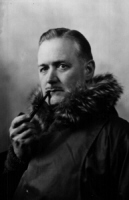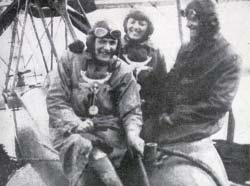“La Vigilance” – the Curtiss HS-2L flying boat registered as G-CAAC. Photo: Canada Aviation and Space Museum.
Remembering a Canadian aviation pioneer
July 17, 2016 – The date marks 40 years since Canadians said goodbye to our first bush pilot, Stuart Graham (1893-1976).
Like many other Canadian lads, Graham joined the Canadian Expeditionary Force in 1915, served in France for 6 months, and was wounded by a sniper. Once recovered, he joined the Royal Naval Flying Service in Britain and flew on anti-submarine sorties over the English Channel. For his actions against two enemy submarines, he was awarded the Air Force Cross.
Back in Canada, Graham became Canada’s first bush pilot in 1919 when he delivered the famous flying boat, La Vigilance, from Halifax, Nova Scotia to Lac-à-la-Tortue, north of Trois-Rivières near Grand-Mère, Québec, in the month of June. The Curtiss HS-2L flying boat was on loan from the Canadian government to the St. Maurice Forest Protective Association for use in forestry patrols. He returned to Nova Scotia two weeks later with the same team – his wife Madge as navigator and Bill Kahre as mechanic – to fly a second HS-2L to Lac-à-la-Tortue.
In July, Graham and Kahre reported the first forest fire spotted from an airplane in Canada. Together, they made 57 flights with these two flying boats during 1919, and proved the value of aerial photography for forest mapping. Delays in obtaining an Eastman K1 aerial camera meant that winter was at hand as the trials were being carried out. Graham records that ice was forming on the lakes and they had to fly through several blizzards to obtain 380 negatives. The results they obtained far surpassed expectations. The trials showed that hardwood could easily be distinguished from conifers, and pine could be told apart from other conifers. Watersheds, swamps and burnt areas all showed clearly.
Despite these results, the St. Maurice Forest Protective Association withdrew its support for the project. The Laurentide Company, an association member, decided to carry on by itself. The two HS-2Ls were licensed as G-CAAC (La Vigilance) and G-CAAD in 1920 when Canadian civil aviation regulations went into effect. Graham himself received his Canadian civil aviation pilot’s license, number 32, on July 20, 1920. A Curtiss Seagull (G-CADL) was added to the fleet that year. With these three aircraft, Graham and Kahre made 70 flights in 1920. On one of these trips, they took two prospectors into the Rouyn-Noranda area where they staked mining claims. This was the first time in Canadian aviation history that aircraft were used to support the mining industry. At the end of the summer flying season, Graham and Kahre both resigned. In 1921, Laurentide Air Service was formed to continue the work of aerial forest mapping and fire spotting.
Graham went on to become Canadian representative for the Curtiss Aeroplane and Motor Company, while Kahre pursued his work as an air engineer. Graham then spent two years at Canadian Vickers Ltd. in Montréal. In 1926, he joined the RCAF, and two years later was appointed to the Air Services Division of the Department of National Defence as District Inspector responsible for the administration of civil aviation in Quebec and the Maritimes.
In 1941, he was promoted to Chief Inspector of Airways at the Department of Transport. In that position, he made a major contribution to Canada’s war effort by planning airfields across Canada for the British Commonwealth Air Training Plan. In recognition of this work he was made an Officer of the Order of Canada. He was again promoted within the Department of Transport in 1943, becoming Superintendent of Air Regulations.
After the war, Graham served on various technical committees of the International Civil Aviation Organization (ICAO), helping develop standards, regulations and operating procedures for both national and international civil aviation. Graham also served as Alternate Council Member for Canada on the ICAO Council and was a Member of the Air Navigation Commission. Over the years from 1951 to 1963, he led ICAO technical assistance missions to countries in the Middle East, Latin America, and Africa, advising national governments on the development of civil aviation. He was decorated with the Star of Menelik by Emperor Haile Selassie in recognition of his guidance in organizing the Civil Aviation Department of Ethiopia.
Among his other honours, he was inducted into Canada’s Aviation Hall of Fame in 1976; awarded the Trans-Canada (McKee) Trophy for lifetime achievement in 1991; and inducted into the Québec Air and Space Hall of Fame in 2001.
In his retirement, Graham sought out as many aviation old-timers as he could find to preserve their memories and their stories from the early days of commercial aviation in Canada. These can be found in the Stuart Graham Collection at the Canada Aviation and Space Museum.





Sounds like an incredible life story.
Purchased on E-Bay a Postcard Stuart sent early in Jan 1956 from Addis Ababa, ‘Greetings for 1956’ and signed Stuart Graham to a Mr G.S. Manners in London – a little sticky gives his address as Box 978, Civil Aviation, Addis Ababa. Converse is a painting of an Ethiopian Airways Convair Cv-240
Agreed! I’m a big Stuart Graham fan too. He must have sent the postcard while he was chief of the ICAO Technical Assistance Mission to Ethiopia. Emperor Haile Selassie honoured him by awarding the Star of Menelik for his work organizing the country’s Civil Aviation Department. I’ve heard of a film in which Graham appeared, “A Day in the Life of a U.N. Adviser,” made at this time. So far, no luck tracking it down.
Thank you for this well-written article about my grandfather! It supplied certain details about his career that I was unaware of. I lived with him for 6 months when I was 7 years old, in Florida surrounded by fascinating artifacts from his travels, in Africa in particular. I knew him as a quiet, gentle man.
How wonderful that you connected with this post and that it brought back happy memories.
From what I have seen in the aviation files at Library and Archives Canada, your grandfather must have been a very special man – reserved, diplomatic, perceptive, kind. Here’s another little story that hints at a wry sense of humour.
Back in 1935, when Canada’s civil aviation was administered by a branch of the Department of National Defence, Stuart Graham was the District Supervisor of Air Regulations, based at St. Hubert, Quebec. My uncle Howard Watt was operating a ski-equipped DH 83 Fox Moth CF-ATX that winter, carrying passengers from Matane across the St. Lawrence River to Godbout and other locations on the North Shore. Inspector Graham telegrammed Watt: “Headquarters insist you carry life preservers or other approved flotation devices.” As Canada’s first bush pilot, Graham appreciated the practical realities of flying in those days. So he sent this suggestion to his Headquarters in Ottawa: “As life preservers are of questionable value with sub zero temperatures it is thought that possibly the Department would require collapsible rubber rafts as emergency equipment for such operations.” I have not checked the air regulations of the day to see the outcome, but you can’t dispute the logic!
Thank you for sharing this. It is a “WOW”, amazing.
I’m from a family with flying experience in WW2 so aviation continues in my veins.
Stuart Graham really was one of the “fathers” of Canadian aviation. I’m glad this article connected so well with your interests. For anyone who wants to research his career in depth, Library and Archives Canada also has a collection of his papers – The Stuart Graham fonds, with 23 pages of text and 35 b&w photographs. Here’s the link:
Link was not present. Could you pls send a copy. I was raised in Grand Mere and a Facebook group “Shawinigan Photos” would surely be interested.
https://www.facebook.com/photo.php?fbid=10216889900259634&set=gm.3851705524847160&type=3&theater&ifg=1
I’ve sent the link to your email address and hope the Facebook group enjoys reading about Stuart Graham. He did so much for aviation in Quebec and in Canada back in the early days!
Thank you for this article. Very interesting to find out the origin of our street names.
Kudos for this interesting story about Canada’s bush pilot pioneer.
Canada’s bush pilots were truly an exciting part of our history and it’s a shame that more hasn’t been written and taught about them.